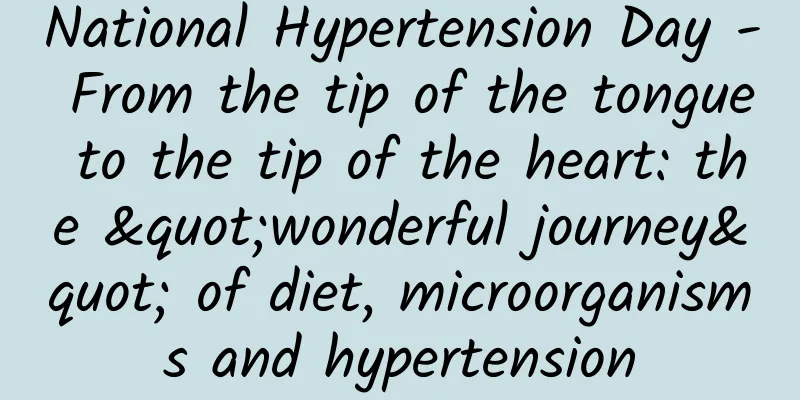National Hypertension Day - From the tip of the tongue to the tip of the heart: the "wonderful journey" of diet, microorganisms and hypertension

|
Author: Li Jing, Associate Professor, Beijing Chaoyang Hospital, Capital Medical University Reviewer: Fan Yifan, Chief Physician, Beijing Chaoyang Hospital, Capital Medical University On the occasion of World Heart Day and National Hypertension Day, we focus on a major issue concerning the health of hundreds of millions of people - hypertension. As a chronic disease that is prevalent worldwide, hypertension is not only an important risk factor for cardiovascular disease, but also an invisible killer that threatens the quality of human life. Here we will jointly explore the close connection between diet and lifestyle, intestinal microorganisms and hypertension, and reveal new ideas for effectively preventing and controlling hypertension by scientifically adjusting diet and lifestyle and maintaining the balance of intestinal microorganisms. Figure 1 Copyright image, no permission to reprint 1. Hypertension: The hidden threat to heart health Hypertension is medically defined as a persistent increase in systemic arterial pressure, often accompanied by damage to target organs such as the heart, brain, and kidneys. In my country, about 300 million people suffer from hypertension, a shocking figure. On average, one in every three adults suffers from hypertension. The long-term existence of hypertension is like boiling a frog in warm water, quietly eroding the blood vessel walls of the human body and increasing the risk of serious complications such as heart disease and stroke. Therefore, raising awareness of hypertension and taking active measures to prevent and control hypertension are crucial to maintaining heart health. 2. Diet and lifestyle: the cornerstone of hypertension prevention and control 1. High-salt diet: a catalyst for high blood pressure A high-salt diet is an important risk factor for hypertension worldwide. Excessive intake of sodium salt can lead to water retention in the body, increase blood volume, and thus increase blood pressure. The World Health Organization recommends that adults should not consume more than 5 grams of salt per day, but in my country, many families' salt intake far exceeds this standard. Therefore, reducing salt intake, choosing low-sodium and potassium-rich salt alternatives, and reducing condiments and processed foods with high sodium content are effective measures to reduce the risk of hypertension. 2. Dietary fiber and intestinal microorganisms: the “micro” power to protect blood pressure Dietary fiber is the carbohydrate component of plant foods that cannot be digested and absorbed by the human body. It is essential for maintaining intestinal health. Dietary fiber is fermented by bacteria in the intestines to produce short-chain fatty acids such as acetic acid, propionic acid and butyric acid. These short-chain fatty acids have anti-inflammatory and vascular function-improving effects, which help lower blood pressure. Foods rich in dietary fiber include whole grains, beans, nuts, and various fruits and vegetables. Increasing the intake of dietary fiber not only contributes to intestinal health, but also indirectly controls high blood pressure by improving the balance of intestinal microorganisms. Figure 2 Copyright image, no permission to reprint 3. Prebiotics and probiotics: “regulators” of intestinal microorganisms Prebiotics are indigestible food ingredients, such as inulin and oligofructose, that promote the growth of beneficial bacteria. Probiotics can directly act on intestinal flora to produce metabolites with antihypertensive effects, such as bifidobacteria and lactobacilli. Prebiotics and probiotics help control high blood pressure by regulating the balance of intestinal flora, reducing harmful substances produced by harmful bacteria, and increasing beneficial metabolites produced by beneficial bacteria. 4. Trimethylamine oxide: a new link between diet and hypertension In recent years, studies have found that intestinal microorganisms can also convert choline, phosphatidylcholine and other substances in dairy products, red meat and egg yolk into trimethylamine (TMA), which is further converted into trimethylamine oxide (TMAO) in the liver. Trimethylamine oxide has the effect of promoting vasoconstriction and raising blood pressure. Therefore, reducing the intake of high-choline and high-carnitine foods and choosing low-choline and low-carnitine foods, such as plant protein, white meat, fish and whole grains, can help reduce the production of trimethylamine oxide in the body, thereby controlling high blood pressure. 3. Gut microbes: a new perspective for hypertension prevention and control As the largest micro-ecological system in the human body, the intestinal microbiota is closely related to the occurrence and development of hypertension. In the intestinal flora of hypertensive patients, harmful bacteria such as Prevotella, Klebsiella, and Fusobacterium increase, while beneficial bacteria decrease. These harmful bacteria may participate in the occurrence mechanism of hypertension by producing inflammatory factors and affecting metabolism. 1. Gut microbes and metabolic syndrome Intestinal microorganisms are involved in regulating the host's energy metabolism, fat metabolism, and sugar metabolism. Hypertension often coexists with metabolic syndromes such as obesity and diabetes. Intestinal flora imbalance may lead to metabolic abnormalities, thereby increasing the risk of hypertension. Therefore, regulating the balance of intestinal flora and improving metabolic syndrome can help reduce the incidence of hypertension. Figure 3 Copyright image, no permission to reprint 2. Gut Microbes and the Immune System There is a close interactive relationship between the intestinal microbiota and the immune system. Intestinal flora imbalance may activate the immune system, trigger an inflammatory response, lead to vascular wall damage and increased blood pressure. Maintaining the balance of intestinal microorganisms and reducing the inflammatory factors produced by harmful bacteria can help reduce the risk of inflammatory response in hypertension. 4. Reasonable diet: a “green prescription” for hypertension management Healthy eating helps prevent and control high blood pressure and reduce the risk of cardiovascular disease. The DASH diet can significantly improve blood pressure levels by providing rich dietary fiber, trace elements such as potassium, magnesium, and calcium, and high-quality protein, while reducing the intake of saturated fat and cholesterol. This dietary pattern emphasizes fruits, vegetables, whole grains, low-fat dairy products, poultry, fish, nuts, and beans, and less sugary drinks and red meat. The Chinese Heart Healthy Diet is a dietary strategy rooted in Chinese dietary culture that aims to prevent and control high blood pressure by adjusting dietary habits. It consists of three different main and side dishes for two consecutive weeks to meet the dietary habits and health needs of the Chinese population. It is a "local remedy" for high blood pressure management to prevent and control high blood pressure and protect heart health through the dietary principles of low salt, low fat, high fiber, and balanced nutrition. V. Comprehensive lifestyle intervention: a comprehensive strategy for the prevention and control of hypertension In addition to dietary adjustments, comprehensive lifestyle intervention is also an important part of hypertension management. Controlling weight, quitting smoking and limiting alcohol consumption, exercising moderately, maintaining psychological balance, and maintaining healthy sleep are all helpful in preventing and controlling hypertension. In particular, in terms of exercise, it is recommended to perform aerobic exercise, resistance exercise, flexibility training, and stretching training according to one's own conditions. These exercises can reduce sympathetic activity, relieve tension, and reduce weight, thereby reducing the risk of hypertension. VI. Conclusion As a global chronic disease, the prevention and control of hypertension requires the joint efforts of the whole society. By scientifically adjusting diet and lifestyle and maintaining the balance of intestinal microorganisms, we can effectively reduce the risk of hypertension and protect heart health. In the days to come, let us work together to build a line of defense for heart health and keep the tree of life evergreen! Through the discussion in this article, we hope to help readers realize the close connection between diet, lifestyle, intestinal microorganisms and hypertension, so that they can adopt a more scientific and healthy lifestyle in their daily lives and jointly resist the threat of hypertension. Let us welcome the arrival of World Heart Day and National Hypertension Day with practical actions and contribute our own strength to heart health! |
Recommend
Don’t think a woman’s big nose is ugly, it has a good meaning!
The nose is one of the five facial features and a...
Can't move the bed when pregnant?
Because pregnancy is very important, pregnant wom...
What are the symptoms of stillbirth at 35 weeks?
At 35 weeks of pregnancy, it has entered the late...
Do I need to fast for a pregnancy blood test?
In order to know the development of the fetus and...
When does a woman enter menopause?
Many people are familiar with the term menopause,...
Five types of menstruation to see women's hidden diseases
The process of a girl growing into a woman must f...
What should I do if I have rhinitis during pregnancy?
For pregnant women, one in five people are prone ...
Women's sagging must be taken seriously
Uterine prolapse is also a common gynecological d...
Which exercises improve cardiorespiratory endurance?
Alternating diversified exercises of different in...
What should women do if they have anal prolapse?
I believe everyone is familiar with the disease o...
How long after marriage is it normal to get pregnant
Getting married, having children, settling down a...
How to regulate irregular menstruation after giving birth
During the childbirth process, women may experien...
What does OCT examination of ophthalmology examine? Who needs OCT examination?
What is OCT? In ophthalmology clinics, we often e...
Are Gram-positive bacteria serious?
Many women feel vaginal discomfort, with symptoms...









